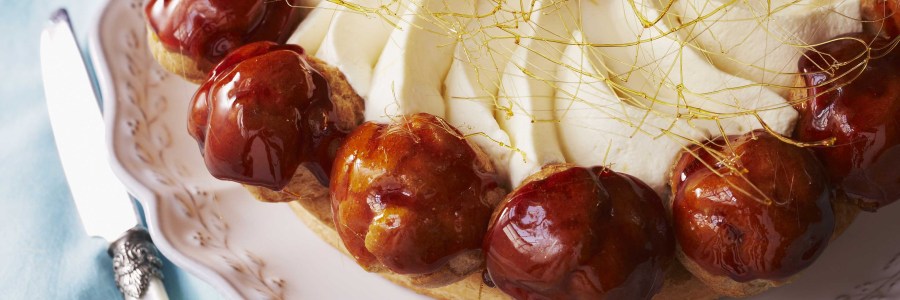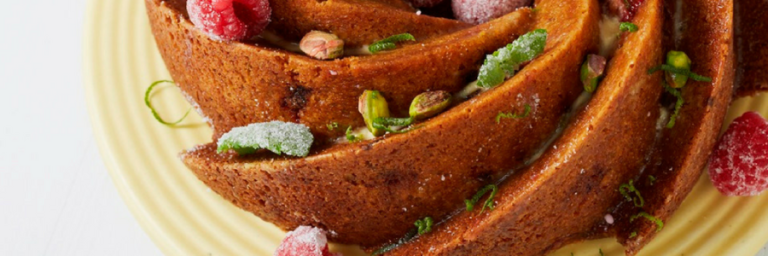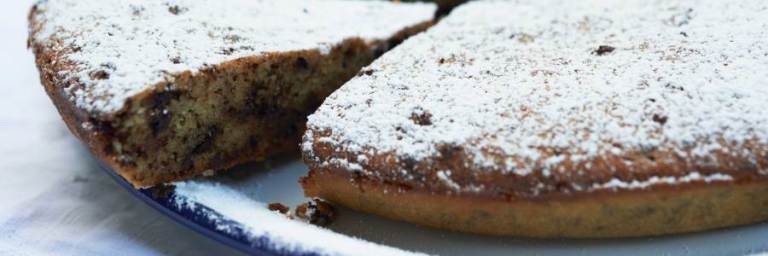Try your pastry skills with our latest GBBO recipe

Feeling inspired to get your bake on after this week’s bake off?
We’re challenging you to test your pastry making skills with this Gâteau St-Honoré – a spectacular creation named after the patron saint of pastry chefs. It’s quite a challenge so make sure you’ve got plenty of tea to help you through it!
You will need:
FOR THE BASE
½ quantity Puff Pastry (see page
22) OR 375g ready-made
all-butter puff pastry, thawed if frozen
FOR THE CHOUX PASTRY
150g plain flour
115g unsalted butter
1 tablespoon caster sugar
¼ teaspoon fine sea salt
225ml water
4 medium eggs, at room
temperature
FOR THE CRÈME ST-HONORÉ
200ml single cream OR 100ml
each double cream and milk
1 vanilla pod, split lengthways
5 medium eggs, at room
temperature
20g cornflour
100g caster sugar
good pinch of fine sea salt
20g unsalted butter, at room
temperature
3 tablespoons orange liqueur
FOR THE CARAMEL
300g caster sugar
good pinch of cream of tartar
6 tablespoons water
TO FINISH
½ quantity Crème Chantilly
1. To make the pastry disc for the base, roll out the puff pastry on a lightly
floured worktop to a large round about 3mm thick. Using a cake tin or a
plate as a template, cut out a 25cm disc, taking care not to drag the knife or
stretch the pastry as you cut. Roll the pastry loosely around the rolling pin
and transfer it to a lined baking sheet. Prick the pastry well with a fork, then
chill for 20 minutes.
2. Meanwhile, heat the oven to 220°C/425°F/gas 7 and make the choux
pastry. Sift the flour on to a sheet of greaseproof or baking paper. Put the
butter, sugar, salt and water into a medium pan. Heat gently until the butter
has completely melted, then turn up the heat and bring the mixture to the
boil. Tip in the flour, in one go, then quickly draw the pan off the heat. Beat
vigorously with a wooden spoon until the mixture comes together to form
a heavy, paste-like dough.
3. Return the pan to low heat and beat the dough for a minute or so until
it is very smooth and shiny and no longer sticks to the sides of the pan.
Tip the dough into a heatproof mixing bowl, or the bowl of a free-standing
electric mixer fitted with the whisk attachment, and leave to cool for a few
minutes. Using a hand-held electric whisk, or the whisk attachment, beat
the dough for a minute. Break the eggs into a jug and beat with a fork just to combine. Gradually beat the eggs into the dough, pouring them into the bowl in a thin, steady stream and scraping down the sides of the bowl from
time to time. When all the egg has been incorporated, beat the paste-like
dough for a further 2 minutes until it is glossy and will hold a shape when
the whisk is lifted.
4. Transfer the choux pastry to the large piping bag fitted with the 1.5cm
plain nozzle. Take the pastry disc, on its baking sheet, out of the fridge. Pipe
a ring of choux around the rim of the disc about 1cm in from the edge.
Pipe the rest of the choux pastry into small, profiterole-like buns on the
other baking sheet(s): aim for shapes about 2.5cm high, and space them well
apart to allow for expansion. Gently smooth down any peaks or pointy tops.
5. Bake the pastry base and the buns in the heated oven for 15 minutes,
then reduce the oven to 180°C/350°F/gas 4 and bake for 10 more minutes.
Remove the base and buns. Prick the inside of the choux ring (on the base)
in 4 places, and poke a small hole in the base of each choux bun. Return the
base and buns to the oven and bake for 5–10 minutes longer until crisp and
golden. Transfer to a wire rack and leave to cool. (Once cold, the base and
buns can be stored in an airtight container for a day – if necessary, crisp up
for a few minutes at 180°C/350°F/gas 4 before using.)
6. To make the crème St-Honoré, heat the cream (or milk and cream) in a
medium pan with the split vanilla pod. Meanwhile, separate the eggs, putting
the whites into a large bowl, or the (clean) bowl of a free-standing electric
mixer fitted with the whisk attachment, and the yolks into a heatproof bowl
set on a damp cloth (to prevent wobbling). Add the cornflour and 25g of
the caster sugar to the yolks and whisk with a hand wire whisk until smooth
and light. Remove the vanilla pod from the cream and use the tip of a small
knife to scrape some of the seeds back into the cream. Pour the hot cream
on to the yolk mixture in a thin, steady stream, whisking constantly. Pour the
custard mixture into the pan, but don’t return to the heat just yet.
7. Add the salt to the egg whites, then whisk the whites* to soft peak stage.
Gradually whisk in the remaining 75g caster sugar, then whisk for another
minute or so to make a thick, stiff meringue.
8. Now put the pan back on the heat and stir the cream mixture vigorously
until it boils and becomes a smooth, very thick custard. Remove from the
heat and quickly stir in the butter and orange liqueur. Fold* the meringue
into the very hot custard in 4 batches. Leave to cool, then cover and chill
for at least 4 hours (or overnight).
9. When ready to assemble, set the pastry base on a serving platter. Pick
the best-looking choux bun to be the centrepiece and put on one side.
Now pick the 20 most even-sized choux buns to form the outer ring (these
all need to be the same height and colour) – save the rest of the buns to
serve as profiteroles.
10. Transfer a third of the crème St-Honoré to the piping bag fitted with
the 0.5cm plain nozzle and use to fill the 21 buns, piping the crème in
through the small hole made in the base. Cover the rest of the crème
(adding any left in the piping bag) and keep in the fridge until needed.
11. Now make the caramel. Put the sugar, cream of tartar and water
into a medium pan and heat gently, stirring frequently, until the sugar has
completely dissolved. Meanwhile, fill a larger pan about a quarter-full of
water and bring to the boil; lift on to a heatproof surface. When the sugar
has dissolved, bring the syrup to the boil and boil rapidly, without stirring,
until it turns into a chestnut-brown caramel. Quickly place the pan of
caramel in the larger pan of hot water – this will keep the caramel warm
and fluid while you work.
12. Working as quickly as possible, dip the top of each filled choux bun in
the caramel – use kitchen tongs to avoid burning your fingers – then set
them upright on a sheet of baking paper and leave to set. Once all the buns
have been dipped and their caramel has set, use a teaspoon to add a good
dab of caramel to the base of each of the 20 for the ring, then quickly stick
them on to the choux ring so they are closely packed (you may not need
all 20). Save the centrepiece bun for later. If during this process the caramel
is getting too thick, return the pan to the heat and gently warm the caramel
until it is fluid again.
13. Pile the remaining crème St-Honoré into the centre of the choux ring,
mounding it gently. Spoon the crème Chantilly into the piping bag fitted
with the St-Honoré nozzle (this is a professional wedge-shaped piping
nozzle), or star nozzle, and pipe in a star pattern over the filling, piping from
the centre out to the choux ‘wall’. Set the reserved choux bun in the centre.
14. Finally, make the spun sugar. This can be a messy process, so remove all
pets and cover the floor with newspaper. Also, try to work in a cool, steamfree
kitchen. It takes some practise to get spun sugar right, so don’t worry
if it’s not perfect. Warm the caramel again. Once it is hot and very runny,
set the pan on a heatproof surface next to the gâteau. Dip 2 forks into
the hot caramel, lift them out and up as high as possible and flick fine trails
of caramel back and forth over the top of the gâteau – as the caramel is
flicked, it instantly cools, and if you keep it moving it will form long, hair-like
strands (if you stop it will form a clump). It’s a good idea to practise a few
times on to a sheet of newspaper before you make the strands to go across
the gâteau. Once draped, the strands can be moved gently but remember
that they are delicate.
15. The spun sugar will last for 1–2 hours in the right dry conditions, but it’s
best to serve the gâteau as soon as possible after decorating.
If you enjoyed this then don’t forget to check out our other GBBO posts for some delicious recipes.
A forgotten classic inspired by Bake Off
Or,
Has this weeks episode of Bake Off got you perfecting your pastry skills? Try this Bakewell Tart recipe from the official Bake Off recipe book





